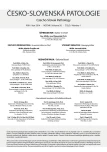Time profile of serum THC levels in occasional and chronic marihuana smokers after acute drog use – implication for drivind motor vehicles
Authors:
Marie Balíková 1; Tomáš Hložek 1; Tomáš Páleníček 2; Filip Tylš 3; Michaela Viktorinová 3; Tomáš Melicher 3; Renáta Androvičová 3; Pavel Tomíček 4; Michal Roman 4; Jiří Horáček 2
Authors‘ workplace:
Ústav soudního lékařství a toxikologie, 1. LF UK a VFN, Ke Karlovu , 1 8 08 Praha
1; Psychiatrické centrum Praha, Ústavní 91, 181 0 Praha
2; Psychiatrická klinika, 3. LF UK, Ruská 87, 0 00 Praha
3; Kriminalistický ústav Praha, Bartolomějská 12, 170 89 Praha
4
Published in:
Soud Lék., 59, 2014, No. 1, p. 2-6
Category:
Original Article
Overview
Cannabis consumption has individual influence to cognitive and psychomotor functions of drivers and it has been generally accepted that driving under influence is risky in the perspective of traffic safety. However, rules how to assess fitness to drive are not quite clear. The psychoactive compound delta-9-tetrahydrocannabinol (THC) impairs cognition, psychomotor behaviour and driving performance in a dose-related manner approximately. After a single drug dose, THC blood concentration peaks within minutes, before the end of smoking, with a subsequent rapid decrease to the analytical limit of detection. Peak euphoria is delayed compared to THC peak blood concentration and physiological and behavioural effects return to baseline within 3-5 hours. In chronic users, the lipophilic THC accumulates in fat tissues, where its slow redistribution into blood is the rate limiting process in its terminal elimination. In our experimental study we have attempted to contribute to this discussion with results obtained from human volunteers – cannabis consumers in Czech Republic. Aim of our study was to document the time profile of serum THC level in occasional and chronic cannabis users. The observational interval covered the time immediately after the drug consumption (an own cigarette/joint) till 24 hours after. Our preliminary results have shown that in occasional users, THC serum levels cannot be detected already 4 hours after usual cannabis dose, whereas in chronic users measurable THC concentrations in serum persist longer. Moreover, some chronic consumers were practically with permanent THC detection during our observation period and also the chronic users consumed higher THC doses significantly related to doses in occasional ones. Presented results of the experimental study with human volunteers confirm a great individual variability of the kinetic profile of THC in blood due to complicated redistribution. The practical forensic question is how long the psychotropic effects of THC can persist after the last drug dose. In chronic users there are well documented indications of long term adverse effects to neurocognitive functions. THC blood level itself can not directly document the intensity of impairment of a driver. Moreover, the concentration of THC in blood at the time of driving is probably substantially higher than at the time of blood sampling. Therefore due to the prevention of traffic risk, some countries adopted per se traffic legislation based on analytical principle with minimum tolerance to illegal drugs in blood of drivers at driving. Low blood concentrations of THC close to the limit of detection of a specific toxicological method (GC-MS or LC-MS) are justified in an effective traffic legislation.
Keywords:
cannabis – delta-9-tetrahydrocannabinol (THC) – psychotropic effects – pharmacokinetics – traffic risk – driving impairment
Sources
1. Ramaekers JG, Robbe HWJ, O´Hanlon JF. Marijuana, alcohol and actual driving performance. Human Psychopharmacology: Clinical and Experimental 2000; 15 : 551-558.
2. Ramaekers JG, Moeller MR, van Ruitenbeek P, Theunissen EL, Schneider E, Kauert G. Cognition and motor control as a function of delta-9-THC concentration in serum and oral fluid: Limits of impairment. Drug and Alcohol Dependence 2006; 85 : 114-122.
3. Hartman RL, Huestis MA. Cannabis effects on driving skills. Clin. Chem. 2013; 59(3): 478-492.
4. Asbridge M, Hayden JA, Cartwright JL. Acute cannabis consumption and moto vehicle collision risk: Systematic review of observational studies and meta-analysis. BMJ 2012; 344: e536; doi: 10.1136
5. Balíková MA, Huestis MA. Forensic aspects of pharmacokinetics and pharmacodynamics of cannabinoids: Assessment of traffic safety. Adiktologie 2008; 8(3): 218-235.
6. Skopp G, Pötsch L. Cannabinoid concentration in spot serum samples 24-48 hours after discontinuation of cannabis smoking. J. Anal. Toxicol. 2008 : 32 : 160-164.
7. Karschner EL, Schwilke EW, Lowe RL, et al. Implications of Plasma delta-9-tetrahydrocannabinol, 11-hydroxy-THC-, and 11-nor-9-carboxy-THC concentrations in chronic cannabis smokers. J. Anal. Toxicol. 2009; 33 : 469-477.
8. Kuepper R, van Os J, Roselind L, Wittchen HU, Höffer M, Henquet C. Conntinued cannabis use and risk of incidence and persistence of psychtic symptoms: 10 year follow-up cohort study. BMJ 2011; 342: d738; doi: 10.1136/bmj d738.
9. Pope HG Jr., Gruber A, Hudson JI, Huestis MA, Yurgelun-Todd D. Neuropsychological performance in long-term cannabis users. Arch. Gen. Psychiatry 2001; 58 : 909-915.
10. Mura P, Kintz P. THC can be detected in brain while absent in blood. J. Anal. Toxicol.2005; 29 : 842-843.
11. Balíková M, Dvořák M. Toxikologická diagnostika a důkaz ovlivnění řidiče návykovou látkou. Státní zastupitelství 2010; 05 : 5-11.
12. Grotenhermen F, Leson G, Berghaus G, et al. Developing limits for driving under cannabis. Addiction 2007; 102 : 1910-1917.
13. Khiabani HZ, Bramness JG, Bjorneboe A, Morland J. Relationship between THC concentration in blood and impairment in apprehended drivers. Traffic Inj. Prev. 2006; 7(2): 111-116.
14. Jones AW, Holmgren A, Kugelberg FC. Driving under influence of cannabis: a 10-year study of age and gender difference in the concentrations of tetrahydrocannabinol in blood. Addiction 2008; 103(3): 452-461.
15. Grotenhermen F, Leson G, Berghaus G, et al. Developing limits for driving under cannabis. Addiction 2007; 102(12): 1910-7.
Labels
Anatomical pathology Forensic medical examiner ToxicologyArticle was published in
Forensic Medicine

2014 Issue 1
Most read in this issue
- Time profile of serum THC levels in occasional and chronic marihuana smokers after acute drog use – implication for drivind motor vehicles
- Medicolegal aspects of atypical firearm injuries: a case report
- Outdoor post-mortem depredation by local fauna
